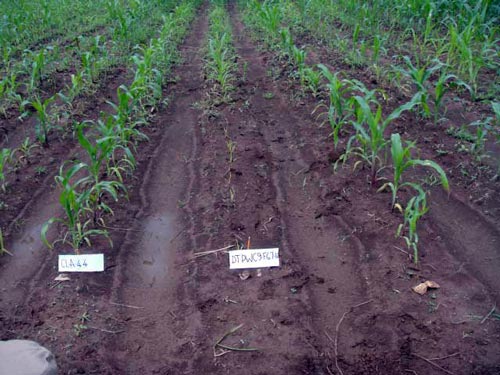 On 19 August 2011, a workshop was hosted by CIMMYT-Colombia for maize producers, association representatives, and educators and students from various local universities, among others, on the advances of a project to increase maize production in Colombia through the development of improved germplasm adapted to the production systems in the Orinoquía region (East Plains). The Orinoquía is an area of plains, covered by pasture and interspersed with rivers and forests; all the rivers terminate in the Orinoco river. The project is coordinated by CIMMYT-Colombia, with support from the Colombian Agricultural Research Cooperation (CORPOICA), Colombian Growers Federation of Cereals and Legumes (FENALCE), International Center of Tropical Agriculture (CIAT), and the Ministry of Agriculture and Rural Development of Colombia. The workshop took place at the CORPOICA Research Center in Villavicencio, Del Meta District.
On 19 August 2011, a workshop was hosted by CIMMYT-Colombia for maize producers, association representatives, and educators and students from various local universities, among others, on the advances of a project to increase maize production in Colombia through the development of improved germplasm adapted to the production systems in the Orinoquía region (East Plains). The Orinoquía is an area of plains, covered by pasture and interspersed with rivers and forests; all the rivers terminate in the Orinoco river. The project is coordinated by CIMMYT-Colombia, with support from the Colombian Agricultural Research Cooperation (CORPOICA), Colombian Growers Federation of Cereals and Legumes (FENALCE), International Center of Tropical Agriculture (CIAT), and the Ministry of Agriculture and Rural Development of Colombia. The workshop took place at the CORPOICA Research Center in Villavicencio, Del Meta District.
As part of the workshop, attendants visited the field and observed the results of trials of maize with tolerance to acidic soils. For this component of the project, 1,000 acidity-tolerant hybrids are being tested in four locations of the Colombian high plains (C.I. La Libertad in Villavicencio; Menegua in Puerto López; and Taluma and Carimagua in Puerto Gaitán) in the Meta District. They are also being evaluated for yield potentialand other important agronomic traits which help to increase production and profitability. Workshop participants observed that the yields of the best hybrids evaluated in C.I. La Libertad exceeded 7 tons per hectare, and it is hoped that yields in Carimagua will reach almost 10 tons per hectare. Based on harvest data, from the 1,000 hybrids a 10% subset of those with the best performance will be selected for evaluation in an increased number of locations from 2012. The goal is to make the best five hybrids available to Orinoquía farmers within 3-4 years. This would make an important contribution to a region where there are enough resources to widen the agricultural frontier and duplicate the current area sown (5 million hectares).
The same project also trialed maize lines known to be susceptible or tolerant to acidic soils. At aluminum saturation levels of 60%, the susceptible lines died during the seedling stage, long before the flowering stage. These results are particularly relevant given that the percentage of aluminum saturation in a native savannah from the Orinoquía is over 90% and only a few plant species survive.
 Capacity development
Capacity development 
